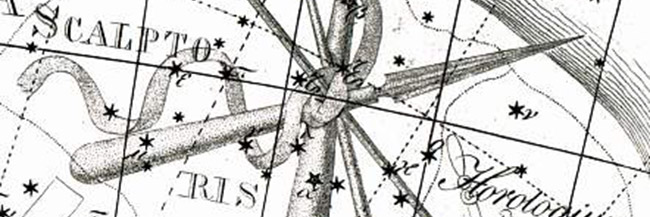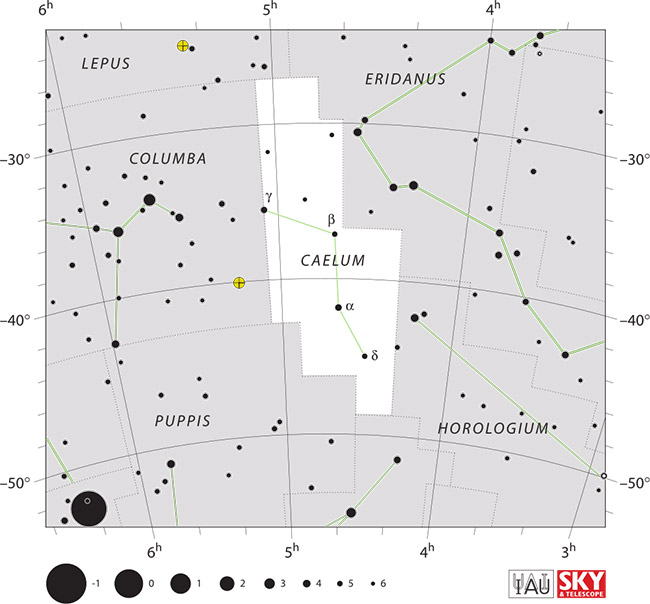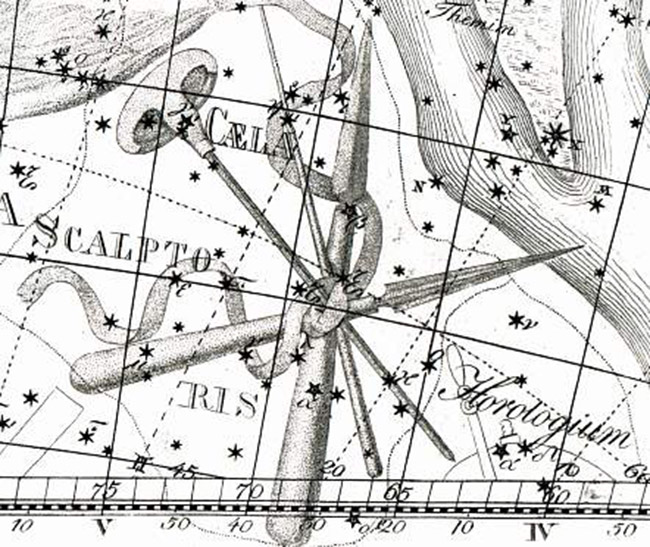Caelum – Constellation Facts
 Bode, Public domain, via Wikimedia Commons
Bode, Public domain, via Wikimedia Commons
Caelum is the eighth smallest constellation in the sky, occupying only 125 square degrees. It is located in the first quadrant of the Southern hemisphere and can be viewed specifically at latitudes between +40° and -90°. The crooked line of Caelum represents “the chisel” and derives its name from the Latin language.
Constellation Characteristics
Caelum was created in the 18th century by, Nicolas Louis de Lacaille, a French astronomer. It is neighbors with the constellations of Columba, Dorado, Eridanus, Horologium, Lepus and Pictor. In addition, Caelum does not contain any Messiers or stars with known planets, but it is home to a few galaxies.

IAU and Sky & Telescope magazine (Roger Sinnott & Rick Fienberg), CC BY 3.0, via Wikimedia Commons
By IAU and Sky & Telescope magazine (Roger Sinnott & Rick Fienberg) CC BY 3.0, via Wikimedia CommonsPlanetary Systems
Being so small, Caelum only has three faint, yet still notable galaxies. Check them out;
- NGC 1679: classified as a spiral galaxy. This deep space wonder is located two degrees south of Zeta Caeli.
- NGC 1571 and IC 2106: these galaxies also call Caelum home.
Main Stars
The constellation Caelum contains three significant stars and two others that are noteworthy. Read on to discover their amazing qualities.
- Alpha Caeli is the brightest star in Caelum (which will be discussed later in detail).
- Gamma Caeli is a star system that has two components to its name; a red giant and a white giant.
- Gamma-1 Caeli is a binary star with an orange K-type giant and a magnitude 8 companion.
- Gamma-2 Caeli is composed of two stars; a yellow-white F-type giant and a star of the spectral type F2IV/V.
- Beta Caeli is a yellow-white F-type main sequence dwarf that shines six times brighter than the Sun. It is also the third brightest in this constellation.
- Delta Caeli is located 711 ight-years from Earth and is considered a blue-white B-type subgiant.
Nu Caeli is catalogued as a yellow-white F-type main sequence dwarf that is situated 171 light-years away.

Caelum shown as Caela Scalptoris on Chart XVIII of the Uranographia of Johann Bode.
Most Shining Star
Out of all the stars that make up the Caelum constellation, none shine brighter than Alpha Caeli – even though it only shines with an apparent visual magnitude of 4.44. This star is estimated to be around 900 million years-old and is made up of two components. The main part of Alpha Caeli is a F-type main sequence star with a companion catalogued as a red dwarf. It is located 65.7 light-years from Earth.
Mythology & History
There are no myths associated with Caelum. It got its name and position in the sky by a French astronomer (Lacaille). He created many constellations to represent tools and instruments. Caelum or the Sculptor’s Chisel (as it is also called) was published in Lacaille’s map of the Southern stars that was published in 1756.
Even though Caelum is small, it is still a fascinating constellation. So the next time you are gazing into the night sky be sure to search out this intriguing figuration of stars.
